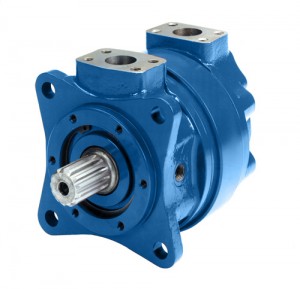By Josh Cosford
 Hydraulic motors are used in any application where the output of mechanical rotational energy is required, such as augers, wheel drives, fans, mixers, and grinders. Their execution is just as varied as their application, coming in motor types such as orbital, vane, gear and the major piston types—bent-axis, radial and axial.
Hydraulic motors are used in any application where the output of mechanical rotational energy is required, such as augers, wheel drives, fans, mixers, and grinders. Their execution is just as varied as their application, coming in motor types such as orbital, vane, gear and the major piston types—bent-axis, radial and axial.
Motors convert hydraulic energy into mechanical rotational energy. Their torque output is a factor of both motor displacement (the theoretical volume of fluid the motor requires to rotate one revolution) and operating pressure. Additionally, a hydraulic motor’s horsepower output is a factor of torque and speed (generally described in revolutions per minute, or rpm)
Each motor type excels in a few applications, but could function as a compromise in others. Orbital motors are the most polyonymous of the group, going by such monikers as low-speed/high-torque (LSHT), gerotor, geroller, and disc valve, to name a few. Mind you, the last three are actually different configurations of the same type of motor—however, their general function is the same, by using an off-set shaft inside-gear arrangement, with either a spool or disc valve.
Orbital motors are the least efficient type (although each motor type has a relatively efficient sweet spot in their pressure and speed curves), but excel at low-speed, high-torque applications, and are also very economical. They are found on the majority of farm-duty applications, such as conveyors or spreaders, and every application where price is the major consideration.
Gear motors are very simple, using the same drive- and idle-gear layout as gear pumps, and although they are not any more efficient than orbital motors for the most part, they are inexpensive and work well at higher speeds. They are most often used when such a combination is required, such as cooling fan drives or pump drives.
Vane motors are the least common of the major types, but are respectable in their efficiency and speed output. They can also be had in large displacements, making them a good choice for high torque applications. They use a rotor with fixed vanes, just as vane pumps do, although some manufacturers use a more complicated design with vanes on the housing as well. These motors can be seen in applications such as winches or drill rigs.
Piston motors are hard to beat in their output and efficiency. The bent-axis piston motor is the champion of high-speed operation, and operate at these high speeds with huge amounts of pressure and torque. Their bent-axis design also makes them very reliable, as they are able to handle 5,000-6,000 psi “’til the cows come home.” They are used in any application where ultra-high speed and torque are required, such as grinders or vacuum pump drives. They’re not cheap, but they are unmatched in their power density.
The radial piston motor is the torque king of the hydraulic motor empire, not only available in gigantic displacements, but also extremely efficient in creating that torque. They’re not as fast as bent-axis motors, but are the top choice for wheel drives or other direct-drive high torque applications. It should be noted that while no piston-type motor can be called inexpensive, they at least provide unparalleled performance at any price.

